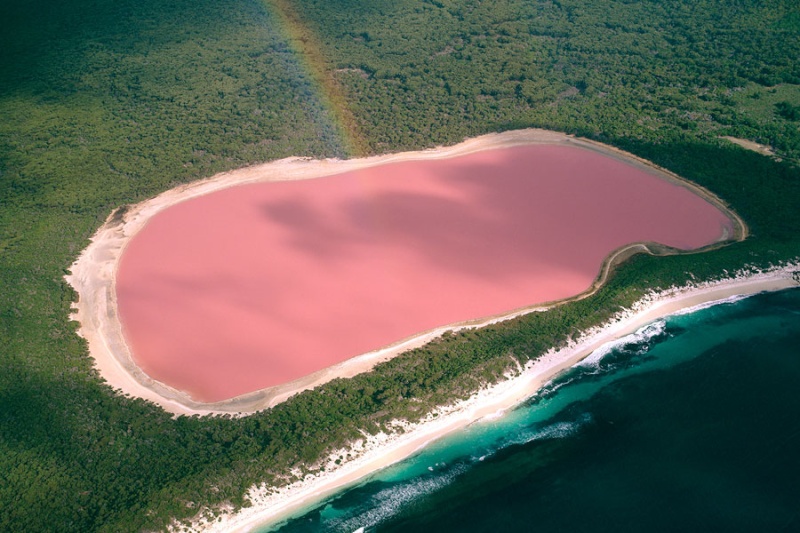Far out ...

Spewing scalding water in all directions, the aptly named Fly Geyser sits about 10 miles from the site of Burning Man, the annual counterculture art festival in Nevada's Black Rock Desert. This geological curiosity was formed accidentally in 1916, when ranch owners drilled a well in the area. They hit water, all right—too bad it measured a piping 200 degrees. The drilling crew plugged the well, but the geothermal water seeped through, leaving behind calcium carbonate deposits that continue to accumulate, forming a 12-foot-high bulbous mound resembling a scoop of rainbow sherbet.
In 1964, a crew drilled a second hole near the first, and once again found hot water, which this time erupted from multiple spots. The tie-dye stains dripping down Fly Geyer's surface are actually thermophilic algae, which thrive in hot, moist environments. Fly Geyser is off-limits to the public, but a Burning Man project director hopes to purchase its ranch land location to develop into an art park and idea incubator, mainly for the development of green technologies.

Blood Falls' grisly appearance comes from its iron-laden waters, which rust when they come in contact with the air, reddening the briny outflow as it trickles down Taylor Glacier onto ice-covered West Lake Bonney. What makes Blood Falls truly bizarre, though, are the roughly 17 microbial species trapped beneath Taylor Glacier, sans light or nutrients and with almost zero oxygen. Geomicrobiologist Jill Mikucki, now at Dartmouth College, has posited that the microbes rely on a metabolic process never before observed in nature: using sulfate as a catalyst to "breathe" with ferric iron and draw energy from nearby trace organic matter.

Lake Hillier sits like a giant punchbowl at the edge of Middle Island in Western Australia's Recherche Archipelago, surrounded by a thick forest of paperbark and eucalyptus trees. A slender strip of shore separates Lake Hillier from the predictably blue Southern Ocean, highlighting the lake's otherworldly appearance.
Theories differ on the origins of the lake's bubblegum hue. Some believe it comes from a dye produced by two microorganisms called Halobacteria and Dunaliella salina, while others suspect the red halophilic bacteria that thrive in the lake's salt deposits. In any case, the lake's color isn't a trick of the light—it's positively pink, no matter where you look.

Years of erosion by vegetation and expanding ice carved Zhangjiajie National Park's narrow, terraced sandstone pillars, some of which climb over 650 feet. The park's steep cliffs and plunging gullies also make the perfect home for more than 100 vertebrate species, including scaly anteaters, giant salamanders, and sprightly rhesus monkeys. Meanwhile, the damp subtropical climate nourishes diverse, sometimes unusual, flora. Take dove trees, for instance.
Known as "living fossils," the white-flowered trees are actually survivors of the fourth glacial period 2.5 million years ago. Zhangjiajie National Park—China's first national park—is one of many within the Wulingyuan Scenic and Historic Interest Area in Hunan Province, named a UNESCO World Heritage site in 1992.
See all ten landscapes ...
http://www.sierraclub.org/sierra/201307/strange-landscapes/slide1-fly-geyser-nevada.aspx

Spewing scalding water in all directions, the aptly named Fly Geyser sits about 10 miles from the site of Burning Man, the annual counterculture art festival in Nevada's Black Rock Desert. This geological curiosity was formed accidentally in 1916, when ranch owners drilled a well in the area. They hit water, all right—too bad it measured a piping 200 degrees. The drilling crew plugged the well, but the geothermal water seeped through, leaving behind calcium carbonate deposits that continue to accumulate, forming a 12-foot-high bulbous mound resembling a scoop of rainbow sherbet.
In 1964, a crew drilled a second hole near the first, and once again found hot water, which this time erupted from multiple spots. The tie-dye stains dripping down Fly Geyer's surface are actually thermophilic algae, which thrive in hot, moist environments. Fly Geyser is off-limits to the public, but a Burning Man project director hopes to purchase its ranch land location to develop into an art park and idea incubator, mainly for the development of green technologies.

Blood Falls' grisly appearance comes from its iron-laden waters, which rust when they come in contact with the air, reddening the briny outflow as it trickles down Taylor Glacier onto ice-covered West Lake Bonney. What makes Blood Falls truly bizarre, though, are the roughly 17 microbial species trapped beneath Taylor Glacier, sans light or nutrients and with almost zero oxygen. Geomicrobiologist Jill Mikucki, now at Dartmouth College, has posited that the microbes rely on a metabolic process never before observed in nature: using sulfate as a catalyst to "breathe" with ferric iron and draw energy from nearby trace organic matter.

Lake Hillier sits like a giant punchbowl at the edge of Middle Island in Western Australia's Recherche Archipelago, surrounded by a thick forest of paperbark and eucalyptus trees. A slender strip of shore separates Lake Hillier from the predictably blue Southern Ocean, highlighting the lake's otherworldly appearance.
Theories differ on the origins of the lake's bubblegum hue. Some believe it comes from a dye produced by two microorganisms called Halobacteria and Dunaliella salina, while others suspect the red halophilic bacteria that thrive in the lake's salt deposits. In any case, the lake's color isn't a trick of the light—it's positively pink, no matter where you look.

Years of erosion by vegetation and expanding ice carved Zhangjiajie National Park's narrow, terraced sandstone pillars, some of which climb over 650 feet. The park's steep cliffs and plunging gullies also make the perfect home for more than 100 vertebrate species, including scaly anteaters, giant salamanders, and sprightly rhesus monkeys. Meanwhile, the damp subtropical climate nourishes diverse, sometimes unusual, flora. Take dove trees, for instance.
Known as "living fossils," the white-flowered trees are actually survivors of the fourth glacial period 2.5 million years ago. Zhangjiajie National Park—China's first national park—is one of many within the Wulingyuan Scenic and Historic Interest Area in Hunan Province, named a UNESCO World Heritage site in 1992.
See all ten landscapes ...
http://www.sierraclub.org/sierra/201307/strange-landscapes/slide1-fly-geyser-nevada.aspx

 Home
Home